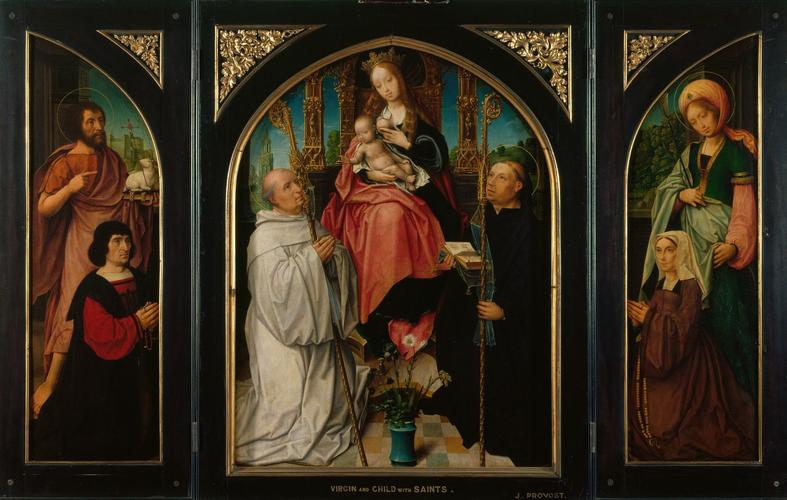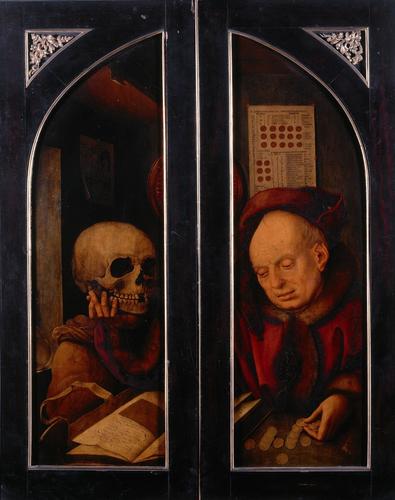Triptych: Virgin and Child with Saints and Donors c. 1525
Oil on oak panel | Panels: centre 78.1 x 59.4 cm; left wing 76.2 x 24.1 cm; right wing 76.2 x 23.3 cm (support, canvas/panel/stretcher external) | RCIN 405816
-
Born in Mons in the mid-fifteenth century and originally trained by his father, Jan Provoost the Elder, Provoost is thought to have completed his training in the workshop of the painter-illuminator, Simon Marmion (c.1425-89) in Valenciennes. He married Marmion’s widow in 1491. Like Gerard David, Provoost was predominantly active in Bruges, but appears to have run workshops simultaneously in Bruges and Antwerp in order to monopolise both markets. Despite the relatively small number of works securely attributed to him, Provoost was an influential artist. He was elected to manage the decoration of Bruges for the Triumphal Entry of Charles V in 1520, and in the same year he met Dürer in Antwerp. In 1521 the German artist was a guest at Provoost’s house in Bruges for three days.
Provoost’s surviving paintings pose problems of attribution since none is signed and only three are dated; one of these, The Last Judgement of 1525 (Groeningemuseum, Bruges), has close stylistic similarities to the present work. One uniting factor in all attributed works is Provoost’s interest in amalgamating complex religious iconography with humanist symbolism. For example, here the religious scenes on the front panels of this devotional altarpiece are complemented by a depiction of a contemporary banker accompanied by a skull on the reverse wings. As Friedländer commented, Provoost’s ‘worldly charm invaded the stillness of the church’.
It is not known who originally commissioned this triptych, and the identity of the two donors depicted on the wings has been lost, but the patron saints accompanying them on either wing - St John the Baptist and St Martha - would undoubtedly have had personal significance. The central panel shows the crowned Virgin seated on a gold carved throne. St Benedict kneels on the right, dressed in black, holding a crosier in his left hand and a prayer book in his right. The Christ Child gestures towards the figure of St Bernard of Clairvaux, who is dressed in a white Cistercian habit. The Virgin Mary presses her right breast to direct milk towards the monk. According to the legend of St Bernard, milk fell from a statue of the Virgin Mary while he was praying before it, thereby identifying the Virgin Mary as the mother both of Christ and of mankind.
The reverse of the wings depicts a banker balancing his accounts with his left hand, while his right hand cradles a skull. The positioning of the skull at the same height as the banker’s head draws a direct correlation between the two. The artist made detailed use of underdrawing which, due to the thinning of the paint layer over time, is now apparent. Originally the artist intended the banker to wear spectacles (to symbolise moral short-sightedness). The paper behind his head lists currency conversions. A circular mirror hangs on the centre of the wall (interrupted by the joins in the two wings) and on the left, next to the window, is a print of The Conversion of St Hubert, possibly indicating that, like St Hubert, this flawed man could be converted to Christianity.
The hem of the Virgin's mantle is inscribed '[MA]TER / [GR]ACIE. MATER. / MISERICORDIE. TV/…OTEC / NO / PARADISI. GLORI[A] / …'
Catalogue entry adapted from The Northern Renaissance. Dürer to Holbein, London 2011Provenance
Acquired by Charles I from the Mantua collection; recorded at Nonesuch Palace in 1639 (no 1); sold for £15 to Marriott on 17 May 1650 from Hampton Court (no 190); recovered at the Restoration and listed in store at Hampton Court in 1666 (no 198); in the Picture Gallery at Buckingham Palace in 1841 (nos 183-5)
-
Creator(s)
Acquirer(s)
-
Medium and techniques
Oil on oak panel
Measurements
Panels: centre 78.1 x 59.4 cm; left wing 76.2 x 24.1 cm; right wing 76.2 x 23.3 cm (support, canvas/panel/stretcher external)










